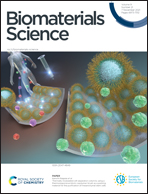Constructing a passive targeting and long retention therapeutic nanoplatform based on water-soluble, non-toxic and highly-stable core–shell poly(amino acid) nanocomplexes†
Abstract
Drug delivery nanoplatforms have been applied in bioimaging, medical diagnosis, drug delivery and medical therapy. However, insolubility, toxicity, instability, nonspecific targeting and short retention of many hydrophobic drugs limit their extensive applications. Herein, we have constructed a passive targeting and long retention therapeutic nanoplatform of core–shell gefitinib/poly (ethylene glycol)-polytyrosine nanocomplexes (Gef-PY NCs). The Gef-PY NCs have good water-solubility, non-toxicity (correspond to 1/10 dosage of effective gefitinib (hydrochloride) (Gef·HCl) (normal drug administration and slow-release) and high stability (120 days, 80% drug retention at 4 or 25 °C). The core–shell Gef-PY NCs present unexpected kidney targeting and drug slow-release capacity (ca. 72 h). The good water-solubility, non-toxicity and high stability of Gef-PY NCs effectively solve the bottleneck question that Gef-based therapy could be used only in intraperitoneal injection due to its insolubility and severe toxicity. Such excellent properties (e.g., water-solubility, non-toxicity, high stability, kidney targeting and long retention) of Gef-PY NCs create their prominent anti-fibrosis capabilities, such as decreasing approximately 40% tubulointerstitial fibrosis area and 68% expression of collagen I within 7 days. This therapeutic efficacy is well-matched with that of 10 times the dosage of toxic Gef·HCl. It is very hopeful that Gef-PY NCs could realize clinical applications and such a strategy offers an effective route to design high-efficiency treatments for kidney- and tumor-related diseases.



 Please wait while we load your content...
Please wait while we load your content...